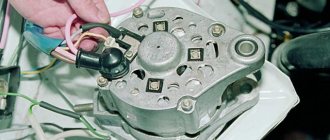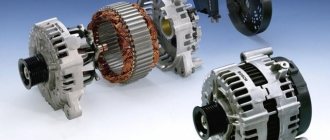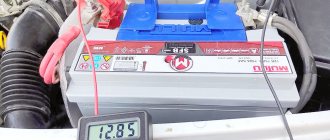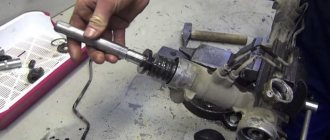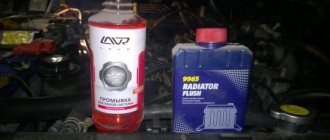01/26/2022 6,249 Auxiliary systems
Author: Ivan Baranov
Currently, many different devices and installations can be used to diagnose vehicle systems. Moreover, each of them can be used for specific purposes. One such mechanism is a generator smoke device. How to make a smoke generator with your own hands and what is the principle of operation of the system - read about it below.
[Hide]
Smoke generator for car diagnostics
This device is needed to identify places where the tightness required for the normal functioning of a particular system is broken - the intake and exhaust tracts of a car, for example.
The smoke generator pumps out thick white smoke, which is clearly visible when it leaks from the path being diagnosed.
The principle of its use is simple, like everything ingenious - smoke is injected into the system or part that needs to be checked, which begins to come out in places where the tightness is broken. In a very similar way, tire shop workers check a wheel for air leaks by immersing it in a bath of water - the escaping air manifests itself in the form of floating bubbles. The smoke generator pumps out thick white smoke, which is clearly visible when it leaks; you just need to connect its output hose to the part being diagnosed, having first “plugged off” all other holes in it. The principle of operation of smoke generators manufactured by various auto equipment manufacturers is to heat liquid oil (like ATF), which, when evaporated, creates the required smoke. The smoke generator includes a compressor for pumping smoke.
Types of smoke generators by ejector location
Smoke generators come with an upper or lower ejector.
The main advantages of the top-mounted option are as follows:
- Increased combustion area volume. The result is more stable smoldering.
- Economical. The wood chips smolder slowly, which reduces firewood consumption.
- Longer pipe life. Being located at a sufficient distance from the place of heating, the parts of the device are less exposed to the negative effects of temperature.
The disadvantages of this type of smoke generators include the need for additional smoke filtering due to the high draft in the chamber.
If the ejector is located at the bottom, large particles of fuel may enter the chimney. Its length must be increased. This is not always feasible in a small summer cottage or the territory of a private house. In addition, exposure to high temperatures reduces the service life of the ejector.
Smoke generators of both types have found their use among smoking enthusiasts. However, in home smoking it is better to use the top type of device.
How to make a smoke generator for a car with your own hands
The cost of the cheapest smoke generator for a car is at least 6,000 rubles, so many car enthusiasts make homemade devices, showing remarkable ingenuity.
Homemade smoke generator for cars with an oil evaporator
Smoke generator diagram for a car
To make such a device you will need:
To manufacture a smoke generator, two necessary conditions are required - sources of compressed air and smoke.
- A container that will serve as the main module. This could be a grease gun, a metal can with a tight lid, or even an old fire extinguisher with a screw cap.
- Glow plug from a diesel engine.
- Time relay.
- Hoses, tubes for air supply.
- Source of compressed air.
Upgrading the grease syringe
The design is based on the housing of a grease gun. It can be purchased for about 300-500 rubles. As in the first case with the pistol, you will have to modify the syringe yourself. You need to install an adapter partition in the middle of the device. A glow plug is screwed into one side of it. The latter can be taken from any domestic diesel engine (for example, from MMZ D 240 or 245, which is installed on the ZIL “Bychok”). In terms of voltage, the glow plug should correspond to 12 or 24V. For the first, it is necessary to apply a power limiting circuit. The simplest and cheapest option would be to use a turn relay. Thanks to this detail, the operating time of the candle is almost halved.
Popular on the site
17 Dec
Auto News
4 283
2022 Kia Sportage. When will the new body appear in Russia?
On the page are the first details about the new Kia Sportage body of the 2021 model year, possible configurations and prices, release date in Russia, photos, technical specifications and video test drive of the new model.
24 Dec
Repair Electronics and equipment
3 511
Symptoms of a faulty engine control unit (ECU)
The engine control unit (ECU), also called the engine control module or transmission control module, is one of the most important components found on almost all modern vehicles.
09 Feb
Engine and its components Ignition system
2 527
Nissan Qashqai 2 2.0 — Do-it-yourself replacement of spark plugs (photo report)
Replacing spark plugs on a modified MR20DD Qashqai 2 engine ( J11
) 2.0 l. according to the regulatory deadlines, it should be carried out over a mileage of 30,000 km or once every 24 months. Since this Qashqai, the second generation, was released not so long ago, it has a different, improved engine (a naturally aspirated engine with an aluminum cylinder block with a high compression ratio), unlike its counterparts, it uses more modern, iridium spark plugs.
19 Aug
Articles Engine and its components
2 482
Error code P0014 (symptoms, causes and solutions)
The vehicle's variable valve timing system improves engine performance and fuel efficiency. It regulates the opening and closing of the exhaust and intake valves, in turn controlling the air-fuel mixture. This control provides more power, better fuel economy or a balanced approach depending on the engine requirements at any given time.
24 Dec
Repair Engine and its components
2 283
Symptoms of a bad or faulty oil pressure sensor
Without the proper amount of oil, your engine will be severely damaged. Several systems in your vehicle are designed to maintain proper engine oil levels and pressure.
28 Dec
Articles Engine and its components
2 119
Symptoms of a bad or faulty intake manifold gasket
Intake manifold gaskets are one of the most important gaskets on an engine. Gaskets are seals placed between engine components before they are assembled to provide a good seal. They can be made from paper, rubber, metal, or sometimes a combination of the three.
18 Dec
Electronics and equipment Electrical circuits
2 097
2022 Jeep Grand Cherokee. Release date of the new body in Russia
Development of the fifth-generation 2022 Jeep Grand Cherokee began with the creation of a new platform. The basis was taken from the Giorgio “trolley”, currently used on the Alfa Romeo Stelvio and Giulia.
09 Jan
Articles Engine and its components Ignition system
1 867
Glow plug relay - how to check its functionality? + Video
Each car has its own glow plug relay circuit. It, like every part, can fail and will have to be replaced. To deal with the rather serious question of how exactly to make a replacement, you need to start with the basics.
28 Jan
Automotive software Repair/operation manuals
1 561
Toyota Avensis - DIY radiator replacement
Before we begin the replacement, let's say a few words about the new radiator and the tool. The tools you will need are: several screwdrivers, a standard set of keys and an empty container for antifreeze.
29 Dec
Tuning Car tuning
954
Mansory Body Kit makes a Rolls-Royce Cullinan look good in white
Unlike Bentley, which has made several versions of its big boy, Rolls-Royce is in no hurry to fix anything. But fortunately, many clients are wealthy enough to afford a complete makeover. The Mansory body kit actually came out much earlier, at the 2022 Geneva Motor Show.
How it works?
The process of operation of a homemade smoke generator The hose is connected to the intake manifold, if necessary, clamping the base with a clamp. On the other hand, a pump or compressor hose should be connected to the nipple. The air coming from the pump or car compressor will light the cigarette and the smoke will go through the design of the homemade smoke generator directly into the car system. If the system is working properly and there is no depressurization, then smoke will not break through the pipes and hoses. If there is still a problem, then smoke will begin to seep out in places where air is leaking, and all you have to do is fix this problem. It is very important not to overdo the air supply, as a high flow can burn the cigarette too much, and it will burn out before the smoke enters the system.
Self-made smoke generators
Craftsmen have long come up with various options for smoke generators for home use. Smoking food without spending a lot on equipment is the dream of many. Even non-professionals can make such a device from available materials. They all operate on a similar principle, the only difference is in the parts from which the smokehouses are assembled.
Electric stove smoke generator
To periodically smoke small amounts of fish or meat, you can make a simple smoke generator using an electric stove.
The following components will be needed:
- electric stove;
- old saucepan;
- pipe or used barrel,
- wire mesh;
- two reinforcement rods;
- sheet of iron, plywood;
- sawdust, wood chips.
The smokehouse should be located in the fresh air, as far as possible from living quarters. You need electricity to operate and may need to use an extension cord. Otherwise, things in the house will smell of smoke.
Step-by-step instruction:
- Prepare the barrel. Thoroughly clean it of any remaining contents. Then, measuring approximately one-third of the height from the top of the barrel, pass several reinforcing rods through its walls. Attach the mesh to the fittings and hang the necessary products from it. The barrel is ready for use.
- Place the tile firmly on a non-combustible surface and connect it to an outlet.
- Place wood fuel in a saucepan.
- Place the pan on a plug-in stove.
- Use the temperature control knob to adjust its heating power.
- Place the barrel on the tile.
- Cover the top of the structure with iron or plywood.
One load will allow this smoke generator for cold smoking to operate for 4 - 6 hours. The process is complicated by the need to constantly monitor the amount of fuel and correct the smoldering temperature. To do this, the barrel will have to be raised periodically.
Although there are shortcomings in this design, many users are attracted by the ease of assembly and low manufacturing costs.
Smoke generator from a spent fire extinguisher
With a little ingenuity, you can turn an old fire extinguisher into a smoke generator, as in the photo.
Work must begin by cleaning the fire extinguisher from old contents and making sure there is no rust on its walls.
Smoke generator assembly:
- Cut the fire extinguisher, retreating about 5 cm from the top. As a result, we get a lid.
- Make a hole in the lid, screw in a tee with pipes.
- Connect a compressor to one of the tubes, and the other will serve to deliver smoke to the smoking chamber.
- Make several holes in the fire extinguisher at a distance of 4-6 cm from the bottom of the fire extinguisher. Through these holes the wood chips will be ignited and the draft will be adjusted.
The finished device can function for 7-10 hours. The operating time depends on the diameter of the fire extinguisher.
Smoke generator made from tin cans
Tin cans are perfect for making a simple smoke generator yourself. This cheap way to get a good smoker will appeal to many.
For this you will need:
- three cylindrical tin cans: two identical, one slightly smaller;
- connecting clamps or metal tape;
- fum tape;
- tee and nut to secure it;
- a piece of copper tube with a small diameter;
- a piece of tube of larger diameter and length for connecting the smoke generator to the smoking cabinet.
Device assembly procedure:
- Clean and dry canning jars.
- Connect two cans of the same diameter using an iron clamp or metal tape. First cut off the bottom of one jar.
- At the bottom of the first can, make holes for igniting fuel and adjusting draft.
- A tee is installed in the bottom of the third, smaller can. It is secured from the inside with a nut. The connection must be very tight and not allow air to pass through.
- A squeegee with a tube is attached to one side of the tee, and the connection is sealed with fum tape.
- Insert the copper tube at one end into the pipe so that it protrudes a few centimeters from the other side of the tee. Seal the entry point. The ejector is ready.
- Attach a larger diameter tube to the second hole of the tee. A smoking chamber will be attached to it.
- Pour sawdust or wood chips into the bottom jars to a height of about two-thirds and set fire through the holes.
- Close the structure from above with an ejector.
- Attach the compressor hose to the other end of the copper tube.
A simple smoke generator is ready.
It should be taken into account that this device must be installed on a flat surface made of non-flammable material, because during operation ash may spill out of the ignition holes.
Safety regulations
A smoke generator is a fire-hazardous device, so fire safety precautions must be observed, as well as the requirements when working with electrical devices. The device is placed on a non-flammable base to prevent the possibility of ignition. The wiring is checked for integrity before switching on. The presence of an automatic switch will prevent device failure and make operation more comfortable.
A homemade smoke generator is a salvation for many smoked meat lovers. With such a device, you can easily create delicious dishes at home that will benefit the body and bring pleasure. To manufacture the device, no special skills or tools are required. In a short time, even a novice master will be able to create a functional and practical smoke generator.
Sources
- https://mytopgear.ru/interesting/raznoe/dyimogenerator-dlya-avto-svoimi-rukami/
- https://avtozam.com/elektronika/auxiliary/generator-dyma-svoimi-rukami/
- https://the-drive.ru/288-professionalnyj-dymogenerator-dlja-avto-kak-sdelat-osobennosti-konstrukcii.html
- https://1pokopcheniyu.ru/dymogenerator/kak-sdelat-dymogenerator
- https://gidrukodeliya.ru/dymogenerator-svoimi-rukami
[collapse]
Smoke generators: from application to operating principle
The name of this device - a smoke generator - speaks for itself. With its help, smoke is produced and supplied to the smoking cabinet.
Description of the operating principle
Sawdust is placed in the lower part of the chamber, usually made of heat-resistant material. Then, through a special hole (blower), they are set on fire. The draft is also regulated by the blower.
As a result of sawdust smoldering in a closed chamber, the required amount of smoke rises upward. At the same time, air is blown into the chamber by a small compressor connected by a hose to a pipe.
The air allows smoke to enter through the tube - the chimney - into the chamber with the products placed. Such a device is called an ejector. The smoke temperature at the outlet is low, since the fire burns slowly and the product is cooked under almost ideal conditions.
What is a smoke generator
To impart a smoky aroma and taste to foods, you need to produce smoke and envelop the food in it. Lighting a fire and laying a path for smoke in the form of pipes is the simplest option, which has many nuances. The temperature of the supplied smoke with this method is high and strict control is necessary, as this affects the final smoking result. For cooling, the chimney is buried underground, which complicates the design. Smoke generators are considered an alternative.
How does a smoke generator work?
These devices are compact and easy to use.
The principle of operation of the device is to produce smoke as a result of smoldering sawdust, which is loaded into a special chamber.
The smoke temperature is low. It moves through the chimney into the chamber with the products thanks to the operation of the compressor, fills it and ensures the preparation of smoked meats. Using a smoke generator, hot or cold smoking is carried out. This affects the structure of the unit.
Let's look at the main mistakes
Beginners are often not satisfied with the smoking result. This is because they make a number of common mistakes:
- Incorrect salting. To prevent food from spoiling, they must be thoroughly salted. For high-quality salting, take 2-3% salt for every kilogram of meat or fish. It is better to take nitrite salt or a mixture of nitrite and table salt. This way, moisture is better removed from the products.
- Pre-drying. Salted meat contains a lot of moisture, so it should be dried before placing it in the smokehouse. Prolonged drying will result in a dry product. It is enough to keep the meat ventilated for 6-10 hours.
- Using the wrong wood chips. Using wet fuel will result in a bitter taste in smoked meats. The same effect is possible if the smoke generator operates too intensively, so its performance must be monitored.
Use without ventilation. After smoking, meat and fish should be ventilated, which will help remove the pungent odor and improve the taste. During your time in the fresh air, not only the taste will change, but also the color.
Considering these simple tips, everyone will be able to prepare stunning masterpieces that will delight even demanding gourmets with their taste, and the cost will be several times cheaper than store-bought dishes.
Manufacturing instructions
If you strictly follow the instructions, the procedure for making a smoke generator for a car will not cause problems. In general, there are quite a lot of designs and circuits for such devices, but we suggest familiarizing yourself with the production of a generator set from a syringe and solid lubricant.
To do this you will need:
- the syringe itself;
- glow plug, these are used on diesel engines;
- wiring with terminals, required for connecting spark plugs;
- heat shrink paste;
- pipes with clamps, as well as rubberized sealing gaskets;
- copper tube, its diameter should be approximately 6 mm;
- drill and set of drills;
- air flow fitting;
- You will also need a metal mesh for washing dishes (the author of the video review of a simple homemade smoke generator is the ZP GARIK channel).
How can you make a smoke generator for a car from such materials:
- First of all, it is necessary to disassemble the syringe, remove the blower hose, as well as the pumping device. For further work, you will need a syringe housing; it is in it that the process of smoke formation will take place, which will subsequently be used for diagnostics. In addition, there is a special hole in the lid that is required for normal operation. It is necessary to install a piece of copper pipe into this hole; its length should be about 16 cm. For better fixation of the tube, it is better to treat the joint with epoxy resin.
- A copper hose will force a compressed air stream into the oil, usually transmission fluid is used for this. Oil is used to generate smoke and then push it out of the housing. The hose is installed all the way, this will block the air flow.
- Next, you will need to drill the copper pipe through the inlet hole. This will allow the air flow to be directed in a specific direction, in particular, into the housing of the generator unit.
- When these steps are completed, it will be necessary to install a fitting into the second hole through which air will escape. Securely secure this item to prevent possible future leakage.
- Now we move on to the next stage - the manufacture of the electrical component of the system. To do this, you will need to install a glow plug from a diesel engine in the bottom cover of the device, and use gaskets for better sealing. Also, the spark plug should be tightened as much as possible, otherwise transmission oil may leak. When the spark plug is installed and fixed, you need to connect a wire with quick-release alligator clips to it.
- Next, a special adapter for the smoke supply pipe should be installed in the hole through which the oil will flow. In this case, it is best to use transparent pipes; this will allow the car owner to control the air flow to the unit or system being diagnosed. You need to install a tip at the end of the nozzle; for this you can use the part that was built into the syringe, but before that you will need to remove the check valve ball from it. You also need to provide the ability to adjust the air flow, but here you need to rely on what kind of air source will be used. In addition, a check valve should also be installed in the supply line.
- Actually, at this point the device assembly procedure can be considered complete, the system is now ready for operation. Next, you will need to fill the working fluid, that is, oil, into the reservoir; its volume should be slightly higher than the glow plug. After a few minutes, you will be able to see the smoke formed in the outlet pipe. The pressure level of the incoming air can be about 0.5-1 bar, but this parameter should be selected more accurately by experimental method. If you have a compressor, then use it; if not, then in principle you can use other options, for example, a spare tire of a car or a pumping device for inflating water mattresses.
- When the manufacturing steps are completed, all you have to do is check the functionality of the system.

